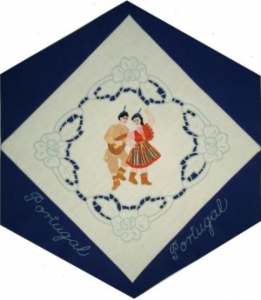Portugal

The Block
Created on beautiful white linen, the Portugal block done by Olivia Abreu is a wonderful example of Madeira cutwork embroidery. This form of needlework, for which the country is so well known, involves working over the edges in fine, buttonhole stitches and then cutting away portions of the background fabric. Pale blue floss outlines a symmetrical floral motif. An embroidered musician and dancer, dressed in colourful traditional costumes, fill the centre of the square, a reflection of the prominent part singing and dancing play in the lives of the people. The young man holds a guitar, often used to accompany the fado, a song that epitomizes saudade, the yearning, romantic aspect of the Portuguese character.
Cultural Profile
Called by some a country ‘on the edge of the world’ because of its location facing the Atlantic Ocean, Portugal is a nation of great seafarers and explorers, where fishing and sea trade are still important. The people are warm and hospitable and believe in traditional values such as the importance of family and friendship. The official language is Portuguese, which shares 89% of its vocabulary with Spanish. It is the fifth most widely spoken language in the world, said to emphasize emotion and renowned for its lyrical qualities.
The country is known for its brightly coloured pottery, its blue azulejo decorated tiles, painted furniture, glass and porcelain, gold filigree jewelry and vivid embroidery. Madeira embroidery, in particular, is recognized the world over as being the finest cutwork. Done mostly by countrywomen, each piece is considered a real treasure. Stitches passed on from mother to daughter ensure the continuance of the tradition and allow the girls to earn extra money for their families. In Castelo Branco, embroiderers use silk over linen background to produce lush designs on large pieces, with up to 6 embroiderers working on a piece. Tapestry making is also alive and well in Portugal, with centres such as Porto Alegre and Araiolos both specializing in the art. Burel fabric is also one of Portugal’s distinctive fabrics. This cloth is first woven out of wool, then processed to make it thicker and very strong. Gold filigree jewellery is also done, particularly in the northern regions of Portugal.
Portuguese have been coming to Canada since 1903, with large scale migration beginning in the 1950s. At one point the Portuguese-Canadian ethnic group was one of the largest language groups in the country. They came because of an economic recession and because Canada offered them greater opportunities. Within three years, little enclaves of Portuguese began to emerge, easing the sense of isolation and establishing a strong sense of family and community, especially in Toronto, Winnipeg and Vancouver and Montreal, particularly in the Plateau Mont-Royal area. There azulejos still grace the front of many houses built by Portuguese immigrants. Today, there are over 429,000 Canadians of Portuguese ancestry in Canada, and their culture is reflected in many areas of the country, from radio and television programs, restaurants and art to colourful festivals celebrated annually.
Sponsor: Shirley and Victor Santos-Pedro, in honour of our mothers: Armanda Santos-Pedro and Florence E. Nelson
